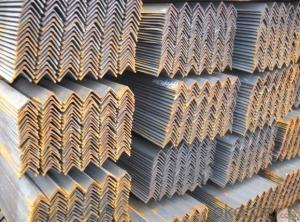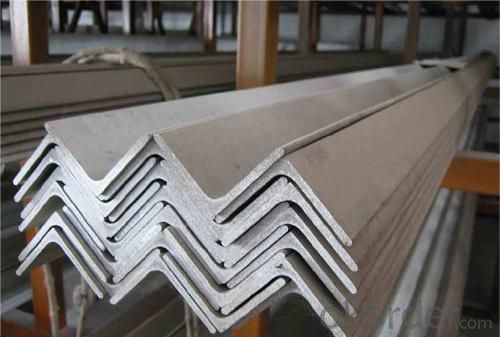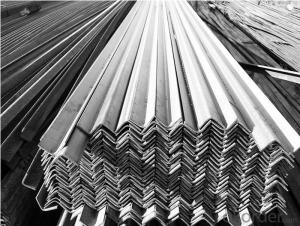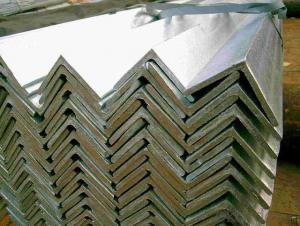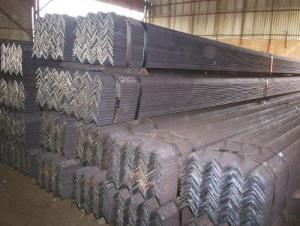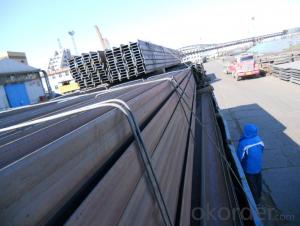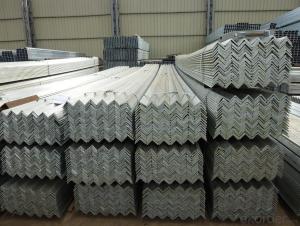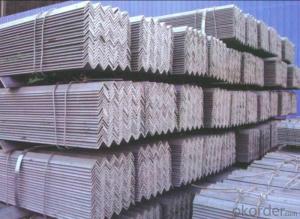A38*38*6 hot sell Equal Angle for construction
- Loading Port:
- Tianjin
- Payment Terms:
- TT OR LC
- Min Order Qty:
- 25 m.t.
- Supply Capability:
- 10000 m.t./month
OKorder Service Pledge
OKorder Financial Service
You Might Also Like
Product Description:
Specifications of Angle Steel
1. Invoicing on theoretical weight or actual weight as customer request
2. Length: 6m, 9m, 12m as following table
3. Sizes

Sizes: 25mm-250mm | ||
a*t | ||
25*2.5-4.0 | 70*6.0-9.0 | 130*9.0-15 |
30*2.5-6.6 | 75*6.0-9.0 | 140*10-14 |
36*3.0-5.0 | 80*5.0-10 | 150*10-20 |
38*2.3-6.0 | 90*7.0-10 | 160*10-16 |
40*3.0-5.0 | 100*6.0-12 | 175*12-15 |
45*4.0-6.0 | 110*8.0-10 | 180*12-18 |
50*4.0-6.0 | 120*6.0-15 | 200*14-25 |
60*4.0-8.0 | 125*8.0-14 | 250*25 |
5. Payment terms:
1).100% irrevocable L/C at sight.
2).30% T/T prepaid and the balance against the copy of B/L.
3).30% T/T prepaid and the balance against L/C
6.Material details:
Alloy No | Grade | Element (%) | |||||
C | Mn | S | P | Si | |||
|
|
|
|
|
|
| |
Q235 | B | 0.12—0.20 | 0.3—0.7 | ≤0.045 | ≤0.045 | ≤0.3 | |
|
|
|
|
|
|
| |
Alloy No | Grade | Yielding strength point( Mpa) | |||||
Thickness (mm) | |||||||
≤16 | >16--40 | >40--60 | >60--100 | ||||
≥ | |||||||
|
|
|
|
|
| ||
Q235 | B | 235 | 225 | 215 | 205 | ||
Alloy No | Grade | Tensile strength (Mpa) | Elongation after fracture (%) | ||||
Thickness (mm) | |||||||
| ≤16 | >16--40 | >40--60 | >60--100 | |||
≥ | |||||||
|
|
|
|
|
|
| |
Q235 | B | 375--500 | 26 | 25 | 24 | 23 | |
Usage & Applications of Angle Steel
According to the needs of different structures, Angle can compose to different force support component, and also can be the connections between components. It is widely used in various building structures and engineering structures such as roof beams, bridges, transmission towers, hoisting machinery and transport machinery, ships, industrial furnaces, reaction tower, container frame and warehouse etc.
Packaging & Delivery of Angle Steel
1. Packing: it is nude packed in bundles by steel wire rod
2. Bundle weight: not more than 3.5MT for bulk vessel; less than 3 MT for container load
3. Marks:
Color marking: There will be color marking on both end of the bundle for the cargo delivered by bulk vessel. That makes it easily to distinguish at the destination port.
Tag mark: there will be tag mark tied up on the bundles. The information usually including supplier logo and name, product name, made in China, shipping marks and other information request by the customer.
If loading by container the marking is not needed, but we will prepare it as customer request.
Production flow of Angle Steel
Material prepare (billet) —heat up—rough rolling—precision rolling—cooling—packing—storage and transportation
Angle, commonly known as Angle on both sides of the cross section is vertical at right angles to each other shape of strip steel. Angle has the points of equal Angle and unequal Angle, two vertical edge length is the same as equal Angle, a long a short for unequal Angle. Its specification in a thick edge width x width x while millimeters said. Angle is the main purpose of: it is mainly used for making frame structure, such as high voltage power transmission tower, steel structure framework on either side of the bridge girder, tower crane on the construction site of pillar and arm, workshop of the column and beam, a small pot shape such as for the side of the road in the place where hung under the shelf, in the window of the solar energy air conditioning rack, etc.
A, Marine Angle steel
Marine Angle of main product description: due to the ship's working environment is bad, so, Marine Angle steel material performance has good toughness, high strength, good corrosion resistance, weldability, and surface properties, etc. The chemical composition of material with normal Angle is not the same. Its main purpose is: it is mainly used for hull internals, etc. 3 N7
Second, the ball flat steel
The ball flat steel is a kind of is mainly used in shipbuilding and to build a bridge in the field of the profiles, including Marine ball flat steel in shipbuilding with auxiliary material. Main product features are:
1, exterior light round, no lines without ribs, and other shaped groove or rib steel surface. This will cause the cohesive force of small flat steel and concrete, and the other the cohesive force of steel bar and reinforced concrete.
2, flat steel smelting in converter, main USES the hot metal as raw material, the harmful elements in molten iron is less, produce the flat steel quality assured.
3, small continuous casting billet length rate is high, can guarantee the flat steel scale rate, meet the needs of users.
Three, L steel
L the Angle steel is also called the unequal different thickness, is adapt to the needs of large ship building and production of new material. L steel except for large ships, can also be used in ocean engineering structure and construction engineering structure of high demand. Its main advantages are:
1, in section height and abdominal advise on the same case, L shape section coefficient and the stiffness is larger than the ball flat steel
2, in the same section coefficient, L was a little thinner than the ball flat steel, steel panel thickness is helpful to improve the quality of the weld.
3, under the condition of same cross section coefficient, increase the storage vessel, improve the economic benefit.
Angle, commonly known as Angle on both sides of the cross section is vertical at right angles to each other shape of strip steel. Angle has the points of equal Angle and unequal Angle, two vertical edge length is the same as equal Angle, a long a short for unequal Angle. Its specification in a thick edge width x width x while millimeters said. Angle is the main purpose of: it is mainly used for making frame structure, such as high voltage power transmission tower, steel structure framework on either side of the bridge girder, tower crane on the construction site of pillar and arm, workshop of the column and beam, a small pot shape such as for the side of the road in the place where hung under the shelf, in the window of the solar energy air conditioning rack, etc.
A, Marine Angle steel
Marine Angle of main product description: due to the ship's working environment is bad, so, Marine Angle steel material performance has good toughness, high strength, good corrosion resistance, weldability, and surface properties, etc. The chemical composition of material with normal Angle is not the same. Its main purpose is: it is mainly used for hull internals, etc. 3 N7
Second, the ball flat steel
The ball flat steel is a kind of is mainly used in shipbuilding and to build a bridge in the field of the profiles, including Marine ball flat steel in shipbuilding with auxiliary material. Main product features are:
1, exterior light round, no lines without ribs, and other shaped groove or rib steel surface. This will cause the cohesive force of small flat steel and concrete, and the other the cohesive force of steel bar and reinforced concrete.
2, flat steel smelting in converter, main USES the hot metal as raw material, the harmful elements in molten iron is less, produce the flat steel quality assured.
3, small continuous casting billet length rate is high, can guarantee the flat steel scale rate, meet the needs of users.
Three, L steel
L the Angle steel is also called the unequal different thickness, is adapt to the needs of large ship building and production of new material. L steel except for large ships, can also be used in ocean engineering structure and construction engineering structure of high demand. Its main advantages are:
1, in section height and abdominal advise on the same case, L shape section coefficient and the stiffness is larger than the ball flat steel
2, in the same section coefficient, L was a little thinner than the ball flat steel, steel panel thickness is helpful to improve the quality of the weld.
3, under the condition of same cross section coefficient, increase the storage vessel, improve the economic benefit.

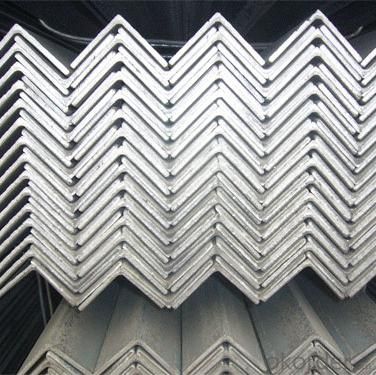
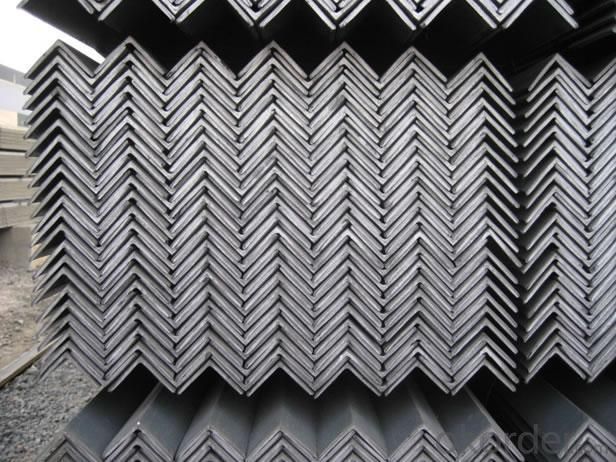
- Q: Can steel angles be used for framing?
- Framing in construction projects can indeed utilize steel angles. These L-shaped metal profiles, also known as angle irons, possess remarkable strength and durability. Their structural stability and capacity to bear heavy loads make them widely employed for framing purposes. Steel angles can be easily manipulated through cutting, welding, and bolting to generate robust frames for diverse structures like buildings, bridges, and industrial facilities. They commonly serve as vertical or horizontal supports, bracing elements, or lintels to ensure stability and structural integrity. Moreover, steel angles can be galvanized or coated to enhance their resistance to corrosion, rendering them suitable for both indoor and outdoor framing applications. In conclusion, steel angles represent a versatile and dependable option for framing in construction projects.
- Q: Can steel angles be used for fencing or gating?
- Yes, steel angles can be used for fencing or gating. Steel angles are often used in construction projects for their strength and durability. They can be used as posts or rails in fencing and gating systems, providing stability and support. Additionally, steel angles can be easily welded or bolted together to create various designs and configurations, making them a versatile choice for fencing and gating applications.
- Q: How do you calculate the buckling strength of a steel angle?
- The buckling strength of a steel angle can be calculated using Euler's formula for buckling. This formula takes into account the length and moment of inertia of the angle, as well as the axial load applied to it. By plugging in the appropriate values and solving the equation, we can determine the buckling strength of the steel angle.
- Q: Can steel angles be used in agricultural buildings?
- Yes, steel angles can be used in agricultural buildings. Steel angles, also known as angle iron, are commonly used in construction due to their strength and versatility. In agricultural buildings, steel angles can be utilized for various purposes such as framing, bracing, and supporting the structure. They can be used to create sturdy frames for walls, roof trusses, and other structural elements. Steel angles also provide excellent load-bearing capacity, making them suitable for supporting heavy equipment or machinery commonly found in agricultural buildings. Moreover, steel angles are resistant to corrosion, which is essential in agricultural environments where exposure to moisture and various chemicals is common. Overall, steel angles are a practical and reliable choice for agricultural buildings due to their strength, durability, and resistance to environmental factors.
- Q: How do you prevent and address corrosion in steel angles?
- There are various effective methods for preventing corrosion and addressing it in steel angles. Here are some steps that can be taken: 1. Ensure proper surface preparation: Before applying any protective measures, it is important to thoroughly clean the steel angles. Use an appropriate solvent or detergent to remove dirt, grease, and other contaminants. 2. Apply protective coatings: To prevent corrosion, it is crucial to apply high-quality coatings. Options include paints, primers, and specialized corrosion-resistant coatings specifically designed for steel. Make sure the coating is suitable for the environmental conditions the steel angles will be exposed to. 3. Consider galvanization: Galvanizing the steel angles can provide excellent corrosion resistance. This involves applying a layer of zinc to create a barrier between the steel and the corrosive elements in the environment. 4. Perform regular inspections and maintenance: Periodically inspect the steel angles for signs of corrosion, such as rust or pitting. Address any corrosion issues immediately to prevent further damage. This may involve removing the damaged coating, treating the corroded area, and reapplying a protective coating. 5. Explore cathodic protection: In critical applications or aggressive environments, it is advisable to consider implementing cathodic protection. This technique involves connecting sacrificial anodes or installing impressed current systems that create an electrochemical reaction to protect the steel angles from corrosion. 6. Control the environment: Minimizing exposure to moisture, humidity, and corrosive chemicals can significantly reduce the risk of corrosion. Proper ventilation, dehumidification, and avoiding direct contact with corrosive substances are important preventive measures. 7. Perform routine cleaning: Regularly clean the steel angles to remove accumulated dirt, debris, or corrosive substances that can accelerate corrosion. It is recommended to use gentle cleaning methods and avoid abrasive materials that could damage the protective coating. Keep in mind that preventing and addressing corrosion in steel angles requires a proactive approach. By implementing these measures, the lifespan of the steel angles can be extended, and their structural integrity can be maintained.
- Q: How do you determine the center of gravity for a steel angle?
- The center of gravity for a steel angle can be determined by finding the point where the weight of the angle is evenly distributed. This can be done by balancing the angle on a pivot point or by using mathematical calculations based on the dimensions and weight distribution of the angle.
- Q: What are steel angles used for?
- Steel angles are commonly used in construction and manufacturing industries for a variety of purposes. One of the main uses of steel angles is in structural applications. They are often used as supports, braces, and reinforcements in buildings, bridges, and other infrastructure projects. The L-shape of the angle provides added strength and stability, making it an ideal choice for constructing load-bearing structures. Steel angles are also used in the manufacturing industry for fabricating various products. They can be welded, drilled, and cut to create custom shapes and structures. They are commonly used as frames, brackets, and supports for machinery, equipment, and vehicles. Additionally, steel angles are used in the fabrication of furniture, shelves, racks, and other storage solutions. Their sturdy construction makes them suitable for supporting heavy loads, making them ideal for applications in warehouses, garages, and factories. In summary, steel angles are versatile and widely used in construction and manufacturing industries for their strength, stability, and adaptability. From supporting structures to fabricating products, they play a crucial role in various applications.
- Q: Can steel angles be used for manufacturing furniture?
- Yes, steel angles can be used for manufacturing furniture. Steel angles are versatile and durable, making them suitable for various applications including furniture manufacturing. They can be used to create strong and sturdy frames, legs, and supports for different types of furniture such as tables, chairs, shelves, and cabinets. Steel angles are known for their strength and structural integrity, making them an excellent choice for furniture that needs to withstand heavy loads or have a long lifespan. Additionally, steel angles can be easily welded, cut, and shaped to fit specific design requirements, allowing for customization and creativity in furniture manufacturing.
- Q: Can steel angles be used in electrical installations?
- Absolutely! Steel angles are indeed suitable for electrical installations. They are frequently employed as reliable structural supports for a range of electrical elements, including conduit pipes, junction boxes, and electrical panels. By offering a robust and long-lasting framework, they facilitate the proper installation and ensure safety. Moreover, steel angles possess great versatility, allowing for effortless customization or alteration to meet specific demands of electrical installations.
- Q: Can steel angles be bolted or fastened together?
- Yes, steel angles can be bolted or fastened together.
Send your message to us
A38*38*6 hot sell Equal Angle for construction
- Loading Port:
- Tianjin
- Payment Terms:
- TT OR LC
- Min Order Qty:
- 25 m.t.
- Supply Capability:
- 10000 m.t./month
OKorder Service Pledge
OKorder Financial Service
Similar products
Hot products
Hot Searches
Related keywords
